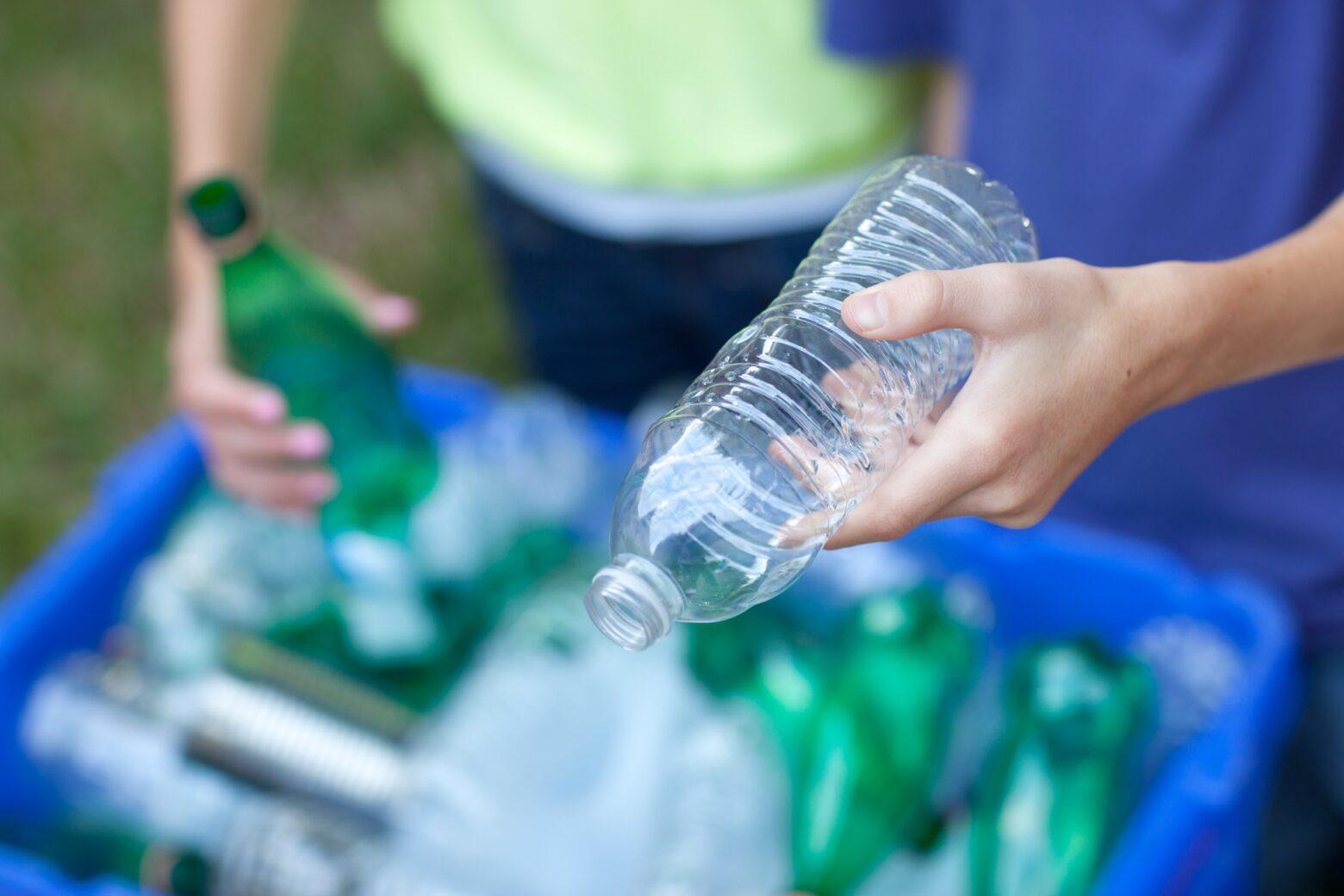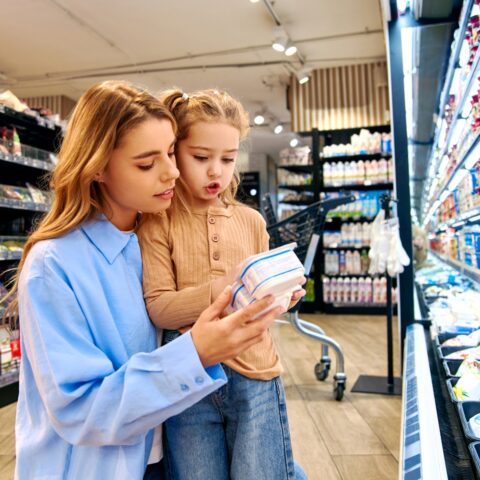Your Guide to Plastic Recycling Symbols

It’s no secret that we’re living in the age of plastic. Plastic production has skyrocketed in recent years; in fact, half of all the plastics ever created were made in just the last 20 years. And it doesn’t look like things are slowing down anytime soon. Production is expected to keep growing by about 5% each year. If this trend continues, we’re on track to produce a staggering 34 billion tons of plastic by 2050, which is three times the amount we have now. [1]
It’s important to reduce our reliance on single-use plastics. But sometimes plastic is unavoidable. So how can we make sure those plastic takeout containers and laundry detergent jugs don’t end up polluting our planet? Recycling plastics is the obvious answer, but it’s not always as straightforward as we’d like. It turns out that less than 10% of plastic waste ever gets recycled, [2] and a big part of the problem is confusion around those little plastic recycling symbols.
RELATED: How to Read Sell-by Dates and Best-by Dates
Each of the seven numbers represents a different type of plastic, and they all have their own set of rules. Before you toss that plastic bottle or container into the recycling bin, take a moment to understand what those symbols really mean.
Plastic #1: PET
PET, or PETE (which stands for polyethylene terephthalate), is most often used for single-use beverage bottles. It’s lightweight, inexpensive, and relatively easy to recycle. [3] One of the advantages of PET is that it doesn’t break down easily during the recycling process. This means there’s less risk of trapping contaminants that could leach out later. However, despite the high demand for recycled PET from manufacturers, its recycling rates remain surprisingly low, somewhere around 27%. [4]
How to Recycle PET
You can usually recycle PET or PETE bottles through most curbside programs. Just make sure they’re empty and rinsed out. Toss bottle caps in the trash; they’re often made from a different type of plastic that can’t be recycled with the bottles. Don’t worry about removing the labels—those get separated out during the recycling process.
Plastic #2: HDPE
HDPE, or high-density polyethylene, is a versatile plastic that is often found in packaging. You’ll often find HDPE in milk jugs, household cleaner containers, some grocery and trash bags, and shampoo bottles. It’s a safer choice because it has a low risk of leaching chemicals, and it’s easy to recycle into all sorts of new products. [5]
How to Recycle HDPE
Most curbside recycling programs will accept HDPE plastics, but check with your local municipality about whether they prefer lids to be left on or off containers like detergent bottles. The spray nozzles on cleaning bottles are trickier. They’re often made from a mix of different plastics and may even contain metal springs, so they usually can’t be recycled.
And while it’s tempting to toss those plastic grocery bags and wraps into your recycling bin, they may actually cause problems at recycling facilities. These thin plastics can get tangled in the machinery, causing jams and disruptions. [6]
Plastic #3: PVC and Vinyl
PVC (polyvinyl chloride) and vinyl are known for their durability and weather resistance, which is why they’re often used for things like pipes and home siding. PVC is also a relatively inexpensive material, so it’s found in a wide range of products and packaging.
It’s worth knowing that PVC can contain chemicals like lead and chlorine, [5] which can lead to the release of harmful dioxins during the manufacturing process.
How to Recycle PVC and Vinyl
PVC and vinyl plastics are rarely accepted in traditional recycling programs, but companies that manufacture plastic lumber may accept these materials. If you need to dispose of PVC or vinyl products, your local waste management provider can advise you on whether to discard them in the trash or take them to a designated collection center.
Plastic #4: LDPE
LDPE (low-density polyethylene) has a wide range of uses. You’ll typically find LDPE in things like squeezable bottles, plastic bags (for bread, frozen food, dry cleaning, and shopping), and even some tote bags and furniture.
How to Recycle LDPE
Recycling plastics with a #4 symbol isn’t always possible in curbside recycling programs, but it’s becoming more common. Check with your local waste management provider to see if they accept items like squeezable bottles and plastic bags. If they don’t, you can usually dispose of LDPE products in your regular trash.
Plastic #5: Polypropylene
Polypropylene (PP) is a type of plastic that can withstand high temperatures, which is why it’s often used for containers that hold hot liquids. You’ll find polypropylene in a variety of items, including some yogurt containers, syrup and medicine bottles, bottle caps, and straws.
RELATED: Safe Food Storage Containers and Best Practices for Storing Food
How to Recycle Polypropylene
Some curbside recycling programs accept polypropylene, so be sure to check your local guidelines. If yours does, you can toss those PP containers in your recycling bin after making sure they’re empty and clean.
It’s usually recommended to throw bottle caps in the trash, even if they’re made from PP. Those small caps often slip through the cracks during the sorting process and end up in the landfill anyway.
Plastic #6: Polystyrene
Polystyrene (PS) is a versatile plastic that can be molded into rigid shapes or foamed. When it’s foamed, it’s often known by the brand name Styrofoam. While it’s lightweight and inexpensive, there are some health and environmental concerns associated with polystyrene.
One concern is that styrene monomer—a component of polystyrene—can leach into food and is considered a possible carcinogen. Additionally, polystyrene is notoriously difficult to recycle, especially in its foam form, which is mostly air. This has led many environmental advocates to push for reducing its use. As a result, most plastic recycling programs don’t accept polystyrene foam.
How to Recycle Polystyrene
It’s not very common to find curbside recycling programs that accept polystyrene, even in its rigid forms. In fact, many manufacturers have switched to using PET instead because it’s more widely recycled.
If you do end up with PS foam products, like packaging or takeout containers, dispose of them carefully. Since they tend to break apart easily, try placing them in a bag, squeezing out the air, and tying it tightly before putting it in the trash. This helps prevent those little pieces from escaping and becoming litter.
Plastic #7: Other or Mixed
The #7 plastic recycling symbol is a bit of a catch-all category for various plastics that don’t fit neatly into the other categories. One example is polycarbonate, a clear, hard plastic that has raised some health concerns due to its BPA content. (BPA, or bisphenol A, is a chemical that can disrupt hormones.)
This category also includes PLA (polylactic acid), a plant-based plastic that’s considered more environmentally friendly because it’s carbon neutral.
How to Recycle Mixed Plastics
These “other” plastics are generally not accepted in traditional recycling programs. It’s always best to check your local municipality’s website for specific instructions on how to handle these materials. They may have special collection programs or alternative disposal guidelines.
Size Matters
Regardless of the type of plastic, a good rule of thumb is to only recycle items that are larger than the palm of your hand. [7] While it’s nice to try and recycle as much as possible, smaller items may get lost on the way to the recycling facility and become litter, or fall through the machinery and cause jams. Plastic items such as cutlery, pill packaging, and loose lids should go in the trash.
It may be hard to come to terms with the fact that not as many items can be recycled as we thought, but the first step toward environmental sustainability is to reduce our use of plastics in the first place. When we cut back on our reliance of single-use plastics, we can reduce the chance of that packaging becoming more waste down the line.
Resources
- Main D. Think that your plastic is being recycled? Think again. MIT Technology Review [Internet]. 2023 Oct 14; Available from: https://www.technologyreview.com/2023/10/12/1081129/plastic-recycling-climate-change-microplastics/
- UN Environment Programme. Beat Plastic Pollution [Internet]. UN environment programme. UNEP; 2022. Available from: https://www.unep.org/interactives/beat-plastic-pollution/
- Consumer Guide to Recycling Codes [Internet]. Available from: https://www.energy.gov/sites/default/files/2021-12/ES_ConsumerGuide_RecyclingCodes.pdf
- Recycling rates of plastic bottle waste U.S. by type 2018 [Internet]. Statista. Available from: https://www.statista.com/statistics/623553/plastic-bottle-recycling-rates-in-the-us-by-material-type/
- Sea Studios Foundation. Smart Plastics Guide [Internet]. Available from: https://www-tc.pbs.org/strangedays/pdf/StrangeDaysSmartPlasticsGuide.pdf
- Plastic #2 (HDPE) – Napa Recycling and Waste Services [Internet]. Napa Recycling and Waste Services. 2022 [cited 2024 Nov 15]. Available from: https://naparecycling.com/guide/2-plastic-hdpe/
- Chiu A. Can plastic fit in the palm of your hand? Don’t recycle it. [Internet]. Washington Post. 2024 [cited 2024 Nov 20]. Available from: https://www.washingtonpost.com/climate-solutions/2024/11/15/small-plastics-recycling-problem-trash/
Maureen Farrar
Maureen Farrar has spent more than 20 years as a writer and editor for several print and digital outlets. She writes about health, fitness and nutrition.
More About The Author




